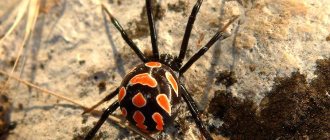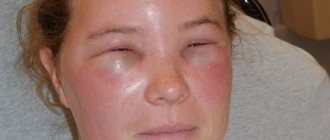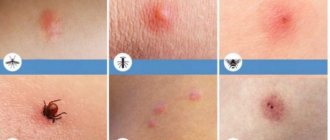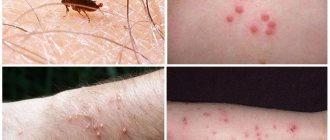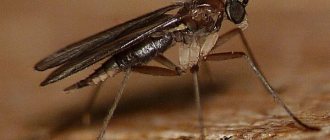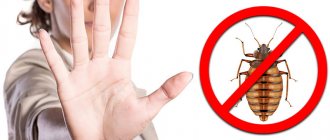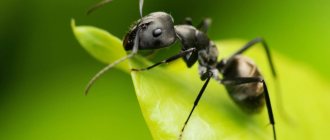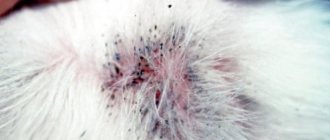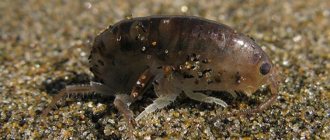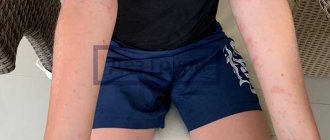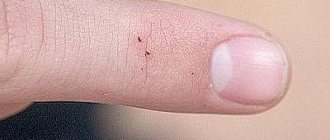Before delving into the topic, it is worth clarifying a few points so as not to mislead anyone, in particular, what a gadfly bite actually is. The fact is that gadflies do not bite. Adult flying individuals do not even eat, since their oral organs are atrophied, that is, they physically cannot bite you - they simply have nothing to do it with. What's the catch then?
People who are not interested in insects from a scientific point of view most often use the names “gadflies” and “horseflies” as synonyms, although in fact they are completely different insects.
- Horseflies are blood-sucking parasites and they do often bite people, livestock and smaller animals.
- Gadflies are insects that do not bite anyone, but lay eggs on the bodies of animals and people, from which larvae then hatch, capable of entering the body in different ways.
Horsefly bites are painful, so if you are bitten by one, you will be able to see it before brushing it off. It will look like a dark, large flying fly. Such bites are treated like most flying insect bites:
- Disinfect the bitten area.
- Apply a healing and soothing ointment.
- If you have allergies, take an antihistamine.
- If symptoms are severe, consult a doctor.
In the case of gadflies, a reasonable question may arise: if the larvae enter the body, can they do this through bites? Yes, they can, but in order to attach themselves to the body of a potential carrier and get inside it, they need time, sometimes up to several days, on average 4–5. In the case of people, such a development of events is unlikely, since the average person takes care of himself and washes at least once a day, which greatly complicates the larvae’s task of infiltration. However, there are exceptions to any pattern. Bodfly larvae can end up inside the human body if:
- The eggs were immediately laid in an open wound caused in some other circumstances, although this is also unlikely if you care for it, disinfect it and heal it.
- The eggs of the gadflies did not get under the skin, but into the gastrointestinal tract along with food.
- The eggs got on your mucous membranes, and you didn’t notice it, for example, you inhaled them.
- The eggs were laid on the head, in the beard, or any other place where a lot of hair grows, and you didn't notice it.
In any case, you will feel the larvae gnawing passages into your body from the outside. It is this process that, in the context of this article, will be considered gadfly bites and will be examined in detail from the perspective of what to do with it. If you find out that you were bitten by horse flies and not by gadflies, in a sense you can consider yourself lucky.
general characteristics
People often call all the large gray flies that attack a person, painfully biting the skin and sucking blood, as gadflies. Horseflies actually do this. The gadfly is not a bloodsucker. This insect lives off the nutrients it accumulated in the larval phase. Their mouthparts are not developed, and they do not feed during their lives. They are more like bumblebees.
But then why do gadflies bite people is a question to which not everyone can find an answer. Males consume only flower nectar, but the fertilized female seeks a warm-blooded incubator. Therefore, the bite of a gadfly has another purpose: to lay eggs under the skin of the victim. Typically, the main hosts for the offspring of these insects are cattle, horses, camels, and deer. The larvae live and develop in the body of their host until they develop into adults. And the life cycle repeats again. Parasitism in the human body is very rare.
Interesting!
There are about 150 species of these insects in the world, but only one attacks humans - the human skin gadfly. Luckily, it is only found in Central America.
Horseflies and gadflies. How are they dangerous, and what is the difference between insects?
01/10/2020 Despite the fact that these representatives of dipterous insects are well known to most people, they are often confused with each other. Let's clarify this issue and determine who is who.
In fact, horseflies and gadflies belong to different families. Their main external distinguishing feature is size. The horsefly looks much larger and more closely resembles an ordinary fly, while some of its varieties are similar to bees and bumblebees.
However, the main distinguishing feature of these two types of insects is their feeding pattern.
Adult gadflies (imago) pose absolutely no threat to either people or animals. Moreover, the mouthparts of these insects are completely reduced, so they are not only unable to bite anyone, but do not feed on anything at all. During their life span, adult insects gradually consume the nutrients that they manage to accumulate while in the larval stage.
It is during the larval phase that gadflies cause the most trouble, since the development of insects occurs under the skin or in the stomach of large animals. At the same time, some types of gadflies are capable of developing inside a person, but we will talk about this in more detail a little later.
What about horse flies? Male horse flies are also harmless because they feed exclusively on carbohydrate foods, which include flower nectar, sweet secretions of insects (usually aphids and scale insects) and plant sap.
A completely different matter is the female horsefly, which has a dual feeding pattern. On the one hand, for its current needs it can also make do with purely carbohydrate foods, but for normal reproduction of offspring it vitally needs protein, which the insect receives along with the blood of an animal or human.
Horsefly bites are very unpleasant and painful. Typically, the affected area quickly swells, turns red, hardens, and may be accompanied by an increase in body temperature.
If a wound caused by a horsefly is scratched, this can lead to infection with dermatitis or necrosis of the skin.
In addition to the pain it causes, the danger of a bite is that the female injects toxic substances into the wound, which can cause a severe reaction in people predisposed to allergies and can even lead to anaphylactic shock. In approximately 10% of cases it ends in death.
History knows many cases when, after being attacked by several horseflies, a person ended up in intensive care, where he needed an urgent blood transfusion.
The female horsefly switches to feeding on blood immediately before laying eggs. If, for some reason, she turns out to be unfertilized, she continues to be content with plant food and flower nectar. However, as soon as fertilization of the embryos occurs, the insect immediately realizes the instinct to search for a victim, and it sets out to obtain blood.
The female inflicts a bite using a fleshy proboscis, inside of which there are sharp piercing and cutting blades. The horsefly first pierces the victim's skin and then proceeds to pump blood. The entire process takes about 6.5 minutes.
The amount of blood that an insect can consume at one time depends on the size of the horsefly, but can exceed its weight by more than one and a half times (up to 200 milligrams). This is the same amount of blood as the bite of 70 (!) mosquitoes.
Horseflies do not disdain the blood of dead animals, so they can become carriers of various pathogenic infections, including such dangerous to humans as filariasis, tick-borne encephalitis, anthrax, tularemia, filariasis, trypanosomiasis, polio and others.
When there is a massive attack of insects on livestock, animals experience a decrease in milk yield and weight loss. At the same time, painful ulcers can be observed at the bite sites, which can fester for a long time.
Let's look at horseflies in more detail.
Horsefly
Horseflies ( lat. Tabanidae
) belong to the order of dipterous blood-sucking insects of the short-whiskered suborder.
They are very ancient insects. Fossil remains of horseflies date back to the Oligocene era.
The largest representative of the species is considered to be the horsefly Tabanus chrysurus
.
This variety can reach three centimeters in length. The species with the smallest size (about 6 millimeters) is Haematopota koryoensis
.
Horseflies can be found in forests, steppe zones and even deserts, but most often these insects live near freshwater bodies, since the larvae of most species require water for normal development.
It is generally accepted that the name “horsefly” comes from the behavior of the female. The fact is that as soon as it bites and starts sucking blood, it seems to fall into a stupor or become “blind”, not paying any attention to what is happening around, although in fact the insect has excellent vision.
The habitat of horseflies is very extensive and includes almost all continents with the exception of Antarctica, Greenland, Iceland, as well as some islands of Oceania.
Currently, more than 4,400 (!) species of these insects have been described, which are grouped into 200 genera. During the time of the Soviet Union, entomologists counted up to 200 species of horseflies on its territory.
Most often, people relaxing on the banks of rivers and lakes, as well as domestic and wild animals that come to the pond to drink, become victims of insects. Horseflies can also attack a variety of small warm-blooded animals, including rodents and even birds.
In urban environments, these insects are very rare.
Horseflies tolerate heat and high humidity well. Insects demonstrate the highest activity and peak numbers in warm and sunny weather, usually at noon, but can attack from the very morning until dusk.
When choosing a victim, they rely primarily on vision, preferring to attack moving objects. As soon as a horsefly flies up to a potential victim, it determines its color, size and degree of mobility (for this reason, you can sometimes see how horseflies mistakenly attack cars and trains, flying into the open windows of vehicles).
Scientists were able to determine that the most attractive object for insects is an object that simultaneously exhibits gradients of light and dark tones (for example, a person wearing a light top and a dark bottom). At the same time, researchers cannot explain the fact that horseflies completely ignore animals such as zebras.
Having discovered a potential victim, the female horsefly begins to actively pursue it, focusing on chemical, tactile and thermal stimuli, and therefore can follow the object for several kilometers.
When a hunting object is detected, the horsefly begins to make short flights from place to place or crawls over the body of the victim in search of the least protected areas. In this case, the female tries to detect the most densely located blood vessels.
Usually, suction to the victim occurs after several unsuccessful attempts. At the same time, the horsefly absolutely ignores the potential danger posed by the object of attack, and therefore it is pointless to drive away the insect. It will either achieve its goal or die.
Description of the insect
The horsefly's body is compact, well-built and has a brown, gray or yellowish color.
The chitinous cover is relatively thin except for the thoracic region and the front of the head.
The chest is massive, wide, powerful and consists of three segments. It is usually covered with small soft bristles.
On the back of the chest there is a large triangular shield.
The abdomen is wide, slightly flattened downwards and includes seven pairs of half rings. Moreover, in males it is pointed, conical in shape, while in females it is more rounded.
The head of insects is large, transverse, convex. In males it is larger than in females and is equal in width to the chest or even slightly wider.
The eyes are complex, faceted, with a metallic sheen that shimmers in different colors. Sometimes you can see dark spots and transverse stripes on them.
In addition to the main eyes, some insects have three more simple eyes, which are usually located on the top of the head and have the shape of a triangle.
In females, the compound eyes are usually separated by a distinct frontal matte stripe, which is absent in males. This feature of insects is a sign of sexual dimorphism.
The wings of horseflies are large, hard, wide and well developed. The longitudinal and transverse veins are clearly visible on them. The wing can be completely transparent or contain dark smoky inclusions, bands and spots.
The method of folding the wings of different types of insects may differ: in some they are spread wide apart, in others they are folded along the body. At the base of the wings there are usually halteres, which are rudiments of the rear pair of wings. They consist of a short narrow stalk on which is a club-shaped head of white, yellow or brownish hue.
The sensitive antennae of insects perceive odors well. They consist of three segments, are located between the eyes and resemble small horns. The length and color of the antennae of different types of horseflies may vary slightly.
The legs of insects are not long and covered with small hairs. At the ends of the tibia of the middle pair of legs there are spurs in the form of sharp spines.
The mouthparts of horseflies are of the piercing-licking type. They are attached to the underside of the insect's head and look like a proboscis. Thanks to the presence of special sharp chitinous plates, the female is able to easily pierce and cut the skin of the victim, provoking the appearance of blood. As soon as the blood comes out, the female begins to absorb it.
The length of the proboscis in a female individual usually does not exceed the size of the head, but in some species, for example in Pangoniinae, it can reach almost half the length of the body.
When a horsefly bites, it injects anticoagulants (substances that prevent blood clotting) and toxins into the victim along with its saliva. As a result, swelling appears in the affected area, which is accompanied by painful itching.
Under the influence of anticoagulants, the blood does not clot for a long time and continues to ooze from the wound.
Life cycle of insects
The life cycle of horseflies, like most insects, includes four developmental phases:
· Egg
· Larva
· Pupa
· Adult (imago)
Horseflies are characterized by gonotrophic harmony, which is a close relationship between the process of digestion and the development of the ovaries (gonotrophic harmony is characteristic of most blood-sucking insects of the order Diptera, including mosquitoes, midges and mosquitoes).
In order to ensure the normal process of embryo formation, the female needs animal protein, which she receives by consuming blood. If the hunt is successful, then after a few days the blood has time to be completely digested. At this time, active maturation of embryos occurs.
As soon as the due date approaches, the female begins laying fertilized eggs, placing them directly next to a freshwater body of water. For this purpose, she chooses damp, cool and heavily shaded places.
The horsefly lays embryos in piles or slides. The insect uses a special adhesive substance with which it attaches eggs to rotten leaves, snags, stones, or places them directly on damp ground.
For different types of horseflies, the number of embryos in a clutch may vary, but on average it ranges from 110 to 700 pieces, and sometimes more.
During one season, under favorable conditions, the female manages to lay up to 3.5 (!) thousand eggs. They have a spindle-shaped shape and are painted in a light milky shade, although within a few hours they darken, acquiring a dark brown or even black color.
The horsefly larva has an oblong body shape, which consists of 12 segments.
The size depends on the type and stage of development of insects. The color of the larvae can be light brown, pinkish, white or greenish. Some varieties may contain spots and stripes on the body.
The larvae feed on organic plant debris, but some can lead a predatory lifestyle, attacking small bugs, worms and other small insects.
By the beginning of autumn, the larvae grow up and go to winter.
The horsefly pupa looks like a butterfly pupa, since it has the same cylindrical and slightly curved body shape, which consists of 8 segments. In the initial phase of development, it is light in color with a greenish tint, but gradually darkens and becomes brown. Some species may have spines on their heads.
The maturation period of the pupa in various species of horseflies takes from 5 to 20 days.
The lifespan of females (imago) is usually no more than a month, while the life cycle of males is even shorter, and most often does not exceed 6 days.
The most common types of horseflies:
· Bullfly ( lat. Tabanus bovinus
). The insect can reach 2.4 centimeters in length
· Common lacewing or moth ( lat. Chrysops relictus
). The insect has a very elegant body color
Late horsefly ( lat. Tabanus glaucopis
)
· Gray horsefly ( lat. Tabanus autumnalis
)
What to do if you are bitten by a horsefly?
If such a problem occurs, it is advisable to wash the fresh wound thoroughly with soap and water, and treat the affected area with hydrogen peroxide, brilliant green or iodine. This simple procedure will prevent nematodes and pathogenic bacteria that may be present in the horsefly saliva from entering the wound.
If possible, an antihistamine should be taken to block histamine receptors.
A gauze swab moistened with a solution of baking soda or boric alcohol will help reduce swelling.
In the absence of medications, you can apply crushed plantain leaves to the wound or treat the bite site with the juice of dandelion, wormwood, and onions.
To protect the skin, it is advisable to apply a small amount of Golden Star balm, clove or eucalyptus oil to exposed areas.
It is believed that plants such as tansy, mint, and wormwood have a deterrent effect on horseflies, which should first be thrown into the fire so that the smoke drives away the annoying insects.
If, despite the measures taken, during the first 24 hours after the bite the redness and swelling on the skin did not disappear, but rather increased in size, you should seek help from a doctor.
As a rule, the horsefly population is small, so if, for example, you are camping in nature for several days, then all adult insects can be destroyed by knocking out one at a time.
Now let's take a closer look at the gadfly.
Gadfly
Modern science knows more than 150 species of these insects.
Gadfly or spider ( lat. Oestridae
) belongs to the family of parasitic dipterous flies.
Insect larvae parasitize mammals and even humans.
The primary victims of gadflies are horses, cows, goats and sheep, as well as wild animals, such as roe deer, elk, deer, and so on. In addition to the severe pain caused to livestock, the larvae devalue their skin, since in especially severe cases it turns out to be completely riddled with holes made by the botfly larvae.
lat. Dermatobia homilis) can parasitize humans
), living in the countries of Central America. However, even in our country, multiple cases of human infection from gadflies are known.
Description of the insect
The body of the gadfly is usually pubescent, ranging from 9 to 25 millimeters in length.
There are short or long soft hairs on the chest.
The head is wide, the eyes are large, faceted and have a metallic sheen that shimmers with all the colors of the rainbow.
The abdomen has a rounded shape (in females) or conical (in males).
The legs of insects are short, thick, and covered with hairs.
The proboscis is either completely absent or significantly reduced.
The wings are large and transparent.
Life cycle of insects
Like horseflies, gadflies have a complete closed chain of transformation, which includes the following phases:
· Egg
· Larva
· Pupa
Imago (adult)
The insect completes its full life cycle within one year.
As already mentioned, an adult male gadfly does not feed, but uses previously accumulated reserves, so by the end of its short life it can lose about a third (up to 36%) of its original weight.
After emerging from the pupa, the insect imago acquires the ability to fly and mate within a few seconds.
Unlike horseflies, gadflies do not have a strict connection to the presence of water, so they can be found far from water bodies. Adults are most active in sunny weather, starting from about the end of May to June, lying in wait for livestock in paddocks, pastures and in areas where animals are kept.
On sunny days, the flight of gadflies can be observed already at a temperature of +6°...+8°С, and on cloudy days at +13°...+14°С.
The period and duration of flight during which mating occurs depends entirely on the climatic and weather conditions in the region. The warmer it is, the longer it lasts.
The female gadfly is highly fertile and can contain up to 700 embryos in its abdomen. Moreover, during one season the insect manages to produce at least five clutches.
In order to lay eggs, females either bite through the victim’s skin, placing the embryos directly into the wound, or use a special adhesive substance to attach them to the animal’s fur without damaging the skin. For this purpose, they usually select areas with a short coat and abundant undercoat in the area of the hungry pit, the soft wall of the abdomen, the groin or the front of the thighs.
Bodfly eggs are oblong in shape, most often white or golden in color (in some species they are brown or black).
Embryos of subcutaneous and gastric botflies have a special appendage in the form of a hook, with the help of which they are firmly attached to the donor.
The body of the larvae consists of 12 or 13 segments and is light in color. As they mature, they go through three age phases of development, and survive the winter while inside the donor.
The gadfly has few enemies, with the possible exception of birds, but even with a low number of insect colonies, they successfully maintain the population due to their high fertility.
Main types of gadfly
Depending on the method of reproduction of insects, entomologists identify the following types of gadflies:
· Gastric ( family Gasterophilus
)
This variety is distributed almost everywhere.
The female gastric botfly usually leaves clutches near the animal's mouth or on areas of the body that it most often licks or scratches with its teeth. As a result, the embryos enter the donor’s gastrointestinal tract, where their further development occurs.
One of the most common species of gastric gadfly is Gasterophilus intestinalis
or horse gadfly.
Infected animals usually develop pathology of the gastrointestinal tract, causing catarrh and other diseases.
The larva of a horse gadfly, getting inside the victim, can reach from 13 to 16 millimeters in length and develops for about a month. At the end of the life cycle, it comes out along with excrement, naturally.
Sometimes the number of larvae on one animal can reach hundreds.
Representatives of gastric gadflies also include the gadfly Gasterophilus pecorum
. Females of this species form clutches right in the grass, in places where livestock usually graze, so that the embryos can get inside the donor along with the food.
The horse botfly larva has been repeatedly discovered in humans. A person can become infected by touching exposed areas of the body to an infected animal. The parasite penetrates the skin and migrates inside, leaving a mark on the surface that resembles a scratch. Over the course of one day, the larva can move a distance of 3-5 centimeters, feeding on soft internal tissues.
This disease is called “creeping disease” or “hairworm” and is treated surgically. They are quite rare.
Cavity ( family Oestrus
)
This type of gadfly belongs to viviparous insects, bypassing the stage of laying eggs.
Cavity botflies are capable of infecting their prey on the fly, managing to lay larvae in the nostrils, eyes, or oral cavity of animals. At the same time, females squirt out a milky-white liquid that contains many parasites.
Penetrating inside the victim, they are localized in the nasal and frontal sinuses or in the pharynx.
The larvae of banded botflies are endoparasites and are capable of causing myiasis.
Among the insects of this group, the most widespread is the botfly Oestrus ovis.
, the larvae of which have been repeatedly discovered in humans (in the mucous membrane of the eye). Severe inflammation usually develops at the site of parasite penetration. Infection can lead to destruction of the eyeball and even cause blindness.
Treatment usually involves mechanical removal of the larvae after preliminary anesthesia of the eyeball.
Subcutaneous (family Hypoderma)
This type of gadfly usually selects cattle, leaving an ovipositor on the animal's skin.
After the larva hatches, it begins to gnaw into the donor's body.
The most common representative of the cutaneous species is Hypoderma bovis
or bull gadfly. Its larvae develop under the skin on the back of cattle.
The female glues the eggs to the animal’s fur, and the larvae that emerge from them penetrate the skin and migrate inside the victim’s body.
The migration routes of the larvae in the host’s body have not yet been precisely determined, but most researchers believe that as soon as the subcutaneous botfly larva leaves the egg shell, it immediately bites into the donor’s body and begins to move upward along the soft internal tissues until it reaches the esophagus. Next, the larva begins to migrate along the vessels and nerve endings up to the spine and, through the openings between the vertebrae, first penetrates into the fatty tissue of the spinal canal, and then strives to reach the upper back.
The larvae need oxygen for normal existence, so they gnaw fistulous openings on the surface of the victim’s back, thanks to which they gain access to air. These holes are painful sores, each containing a parasite's spiracle. Externally, they look like large nodules (skin myiases).
Migration of larvae inside the victim can occur in different ways, depending on many factors, but primarily this is due to the timing of the flight of insects.
The total duration of stay of the larvae in the esophagus and spinal canal has not yet been precisely established. However, being in the donor’s body and feeding on its internal tissues, the larvae of the bovine gadfly are capable of reaching 17 millimeters in length.
Towards the end of development, the parasites leave their shelters and fall out onto the ground, where further insect pupation occurs.
The development of the pupa, depending on the subspecies of the gadfly, takes about one month until the adult emerges from it, as a result of which the insect development cycle repeats.
Cases of parasitism of the bovine gadfly on humans have been repeatedly recorded. Larvae were found both under the skin and in the eye.
While in the human body, they usually do not migrate, but form a subcutaneous tumor-like formation, which is usually removed surgically.
There have also been cases of the parasite penetrating into the human brain, which ultimately resulted in death. Alas, even with the modern level of medicine, it is not yet possible to timely detect and remove migrating larvae from the head.
Most species of gadflies do not care on which representative of the class of mammals they lay their embryos. At the same time, there are strictly selective species of insects, for example, the northern subcutaneous insect Oedemagena tarandi
, living on deer, sheep gadfly
Oestrus ovis
, hook gadfly
Gasterophilus intestinalis
, choosing donkeys and horses as victims.
There are species of gadflies that prefer to attack wild animals, for example, the gadfly C. emasculator Fitch
parasitizes American squirrels or
Gastrophilus Rhinocerontis
, which prefers to attack rhinoceroses.
Ways to fight and protect against the gadfly
To protect livestock from gadflies, animals should be provided with good care, adequate nutrition and timely cleansing of the body from embryos and larvae.
Another preventative method of protection is the destruction of brood sites and prevention of the emergence of adults from the infected substrate. In this case, it is important to avoid contact with infected material, which may include excrement of infected animals and their carcasses.
To protect livestock, gadfly repellents are usually used, and extermination measures are also taken to destroy the adults.
To protect yourself from insects in your summer cottage or garden plot, it is advisable to mow the weeds in a timely manner. In addition, remembering that the gadfly reacts sensitively to odors associated with the life of people or animals, it is necessary to promptly treat latrines with preparations that destroy odors. For the same reason, it is advisable to place manure and compost heaps away from housing.
Special adhesive tapes designed for catching flies, which are usually placed in places where gadflies are likely to appear, also help protect against winged insects.
Dried cloves are among safe folk remedies that are used to repel insects. For this purpose, you should take one teaspoon of the dried plant and infuse it in 200 grams of cologne or alcohol.
Use the resulting solution to treat clothing and wipe open areas on the body.
The aromas of lemon, orange and mint also have a good deterrent effect. Essential oils produced from these plants can be used for this purpose.
If you find suspicious lesions on your body that resemble an infection with a parasite larva, you should immediately consult a doctor.
Main conclusions
· There are many more varieties of horseflies than gadflies.
· The body size of the gadfly is much smaller than that of the horsefly.
· Horseflies are blood-sucking insects, but gadflies are not.
· Horseflies lay eggs near bodies of water, and gadflies lay their offspring on mammals.
· Gadflies are parasites, horse flies are not.
· A horsefly bite is more painful and its symptoms last longer, but infection with a gadfly larva is much more dangerous and can pose a serious threat to the health of animals and people.
Share on social networks:
General information about horseflies
Horsefly
A simple person who does not have serious knowledge of biology cannot distinguish a gadfly from a horsefly, which belongs to the order Diptera, but knows that the bite of a gadfly can be painful, so he is afraid of such an insect. The horsefly is a blood-sucking parasite. It lives in forest, taiga, forest-steppe zones. In arid areas, the insect can be found mainly near rivers and lakes; in the mountains it spreads to the borders with eternal snow.
Horseflies are popularly called gadflies. Only fertilized females, who need blood for the development of eggs, bite humans and animals. Males are smaller in size and feed on plant nectar. Females have a proboscis in their mouthparts, with which they cut the skin of the victim and inject substances into the wound that prevent blood clotting.
The length of the insect ranges from 6 to 30 mm. The color of the wings is gray, marbled, or it can be variegated. Bloodsuckers fly in good weather without rain or wind. The air temperature should not be lower than +15, but not higher than +32 degrees. Outside these temperature limits, bloodsuckers are inactive.
On a note!
The most common representatives in our country are rainflies, lacewings and horseflies. They show noticeable activity before the rain, but in wet weather you will not see them. Only rainflies can attack humans even during light precipitation.
Why do insects bite?
Insects bite for 2 reasons:
- show aggression in self-defense;
- human blood is their food.
In their understanding, a person represents a potential danger. Insects protect their habitat and offspring, and therefore behave aggressively. Bees and wasps are kept away from the hives, protecting the colonies and the honey.
Blood-sucking insects are hungry. Many people know that only female mosquitoes bite people - they need human blood as an additional source of protein to reproduce. Male mosquitoes feed on nectar and plant sap.
The compositions are low toxic to humans and have a repellent or exterminating effect on insects.
What happens if a gadfly bites
Bite of a gadfly
If a gadfly bites a person, it is impossible not to notice, as a strong burning and pain is immediately felt, redness appears on the skin, and allergic reactions may occur. A photo of a gadfly bite clearly demonstrates the consequences of an insect attack. Blood in a wound does not clot for a long time, so you need to try to get rid of all the insects so as not to be attacked again. Gadflies find their prey with their eyes, which means they can escape from the bloodsucker.
Induration, swelling and redness immediately appear after a gadfly bite. The skin begins to itch and itch. A person with allergies may experience dizziness, fever, enlarged lymph nodes, swelling and severe redness in the bite area. If no complications occur in the form of allergic reactions (insect saliva is an allergen), then all these unpleasant phenomena disappear after a few days.
The gadfly's bite is very itchy. A person scratching the skin around a wound can introduce an additional infection that will require further treatment. But an allergy to a gadfly sting is quite rare. There are practically no cases of poisoning of the human body due to a horsefly bite Photo of a gadfly bite or severe allergic reactions in real life. But sometimes Quincke's edema can even occur.
The gadfly can be dangerous because it is a carrier of diseases such as:
- tularemia;
- anthrax;
- filariasis.
These diseases are transmitted through blood, which the insect can receive from sick people or animals.
Important!
It is difficult to treat such diseases, so when going into nature, you should think about protective equipment in advance. If possible, it is advisable to take the insect to a laboratory, where it will be determined whether it is the causative agent of the infection.
A bite can cause serious illness, so do not delay visiting a doctor.
Possible consequences
Possible consequences of insect attacks include:
- Severe swelling of the damaged area of skin and surrounding tissues. The tumor quickly increases in size in the first hours after the bite, spreading to surrounding tissues. This happens due to the toxins contained in the gadfly’s saliva, which it injects when biting under the skin of the victim. As a rule, swelling is accompanied by severe itching, pain, and redness of the skin. If a person is allergic, swelling affects the entire limb or the area of injury. The most dangerous is considered to be a bite to the head; swelling spreads to the larynx, affecting the respiratory tract, which leads to suffocation.
- The appearance of nodes and bumps at the site of the bite. As a rule, such formations are painful. Over time, the nodes and bumps increase in size, causing great discomfort to the victim. The formation of nodes and bumps is a consequence of toxic insect saliva getting under the skin. As a result of the bite, insect eggs remain under the skin. Once mature, the eggs grow into parasites that can crawl out.
- Allergic reactions. Manifest in the form of rash, itching, swelling.
- Infection in the wound. This usually happens when a person scratches the bite area vigorously. Due to infection in the wound, it begins to fester.
- Swelling of the lymph nodes.
Depending on the characteristics of each individual person, the consequences of gadfly bites acquire varying degrees of severity. It all depends on the person’s age and whether he or she has chronic diseases. For some, there will be no trace of the bite the next day, while for others there will be serious consequences requiring medical treatment.
Manifestation of a parasite bite
Consequences of a gadfly bite
If you look at the photo of the symptoms of a gadfly bite in a person, you can note that they are very similar to a wasp sting, namely:
- pain;
- burning;
- edema;
- skin redness;
- itching;
- poor blood clotting;
- the bite site on the skin acquires a certain character, a tumor similar to a neoplasm appears.
On a note!
The consequences of a gadfly bite, including an allergic reaction, may go away in a couple of days if the wound does not get infected and purulent inflammation does not develop as a result.
How to ensure that a child does not get an infection due to a bite?
After the child is bitten, have a conversation with him. Tell him not to scratch his wounds. Explain that this will have consequences. For the reason that it can introduce an infection inside the wound.
Tell your child to wash their hands regularly. Trim his nails. You need to make them as short as possible.
Make sure your child does not scratch his wounds. If you see this, then remind them that doing this is dangerous. Also, during treatment of a bite, it is very important for a child to wash regularly in the shower and bath. To avoid introducing infection into your skin.
What to do if you are bitten by a gadfly
Not all people have encountered these insects, so they have no idea how to treat a tumor from a gadfly bite. If a person is bitten by a gadfly while on vacation, then appropriate measures must be taken immediately. Delay can lead to unpleasant consequences. You should always have the necessary medications on hand that could be used as first aid for a gadfly bite.
Not many people know what to do when their hand is swollen, their temperature rises, or they experience nausea. There is no basic knowledge about how to relieve the itching from an insect bite. Many mothers do not know which remedy for horsefly and gadfly bites is designed to protect babies. Children's skin is very delicate, which is why it is so attractive to all blood-sucking creatures.
If it happens that a gadfly has bitten a child, regardless of whether the leg or arm is swollen, the following actions should be taken immediately:
- press down firmly on the bite site to prevent the spread of harmful substances from the parasite’s saliva;
- relieve itching by cooling the swelling with ice or any cold object;
- wash the wound with cool soapy water;
- treat the bite with any antiseptic: iodine, hydrogen peroxide, brilliant green, alcohol.
You should consult a doctor for help if a large number of insects have bitten a person, or he or she has developed a severe allergy in response to a toxin that has entered the blood along with the bloodsucker’s saliva. If no complications are observed, then the insect bite can be treated at home.
Use of pharmaceutical drugs
Medicines to relieve swelling from a bite
It happens that the body has an inadequate response to the action of the gadfly allergen. In this case, you need to relieve swelling from the bite with more effective means:
- Suprastin, Tavegil, Claritin will quickly relieve allergies;
- a compress of ammonia, soda solution, or any mint toothpaste will cope with itching;
- It is worth anointing the bite with an ointment containing corticosteroids (hydrocortisone, Sinaflan, Advantan) so that the wound does not become inflamed;
- You can use an ointment for bloodsucker bites based on herbal components or chemical components.
If it is impossible to use the services of a pharmacy, it is recommended to use natural resources, such as:
- plantain;
- mint;
- dandelion in any part of it;
- yarrow;
- parsley.
You can name many more plants that stop bleeding and have an astringent and anti-inflammatory effect. It is recommended to treat swelling with lemon, onion or garlic, rubbing the inflamed area with a slice.
Precautionary measures
Bite of a gadfly
To prevent gadflies from biting on vacation or while working outdoors, certain conditions must be observed:
- do not wear clothes that are too bright, as insects react to color;
- It is better not to use sweetish perfumes; gadflies are attracted to this smell;
- stay away from water, grass and thickets - the favorite habitats of insects;
- after bathing, dry your body and change into dry underwear;
- in the forest, wear light clothing that covers the body and limbs;
- use chemical or natural repellents;
- have mosquito nets on the windows and doors of the house, in tents, so that you will never know how a gadfly and horsefly bite a defenseless person;
- protect the locations of children's beds, cover strollers with special covers that insects cannot penetrate through.
A gadfly bite on the human body always causes pain and swelling of the tissues adjacent to the wound. In the first minutes after the skin is punctured by a bloodsucker, the gadfly’s bite looks like a papule. Later the tumor spreads to neighboring tissues. Sometimes the papule does not turn into a large swelling, but becomes a lump at the point of the bite. To ensure that no trace of the insect bite remains, the resulting lump can be surgically removed.
It's not just people who suffer from horse flies. These parasites do not disdain any warm-blooded animals when they need to drink blood to breed their offspring. If there is no living flesh, then they drink blood even from carrion. Our four-legged pets are also not immune from attacks by these monsters. Pet owners do not know how to treat a gadfly bite on an animal. After all, the dog cannot say anything or show the location of the insect infestation. It is especially dangerous if the midge has bitten an animal in the eye. In this case, the pet may remain blind or die from painful shock. Therefore, if a gadfly has bitten a dog, you must contact a veterinary clinic.
